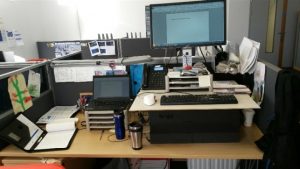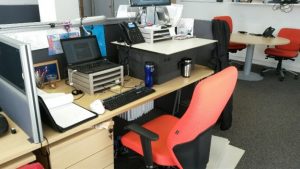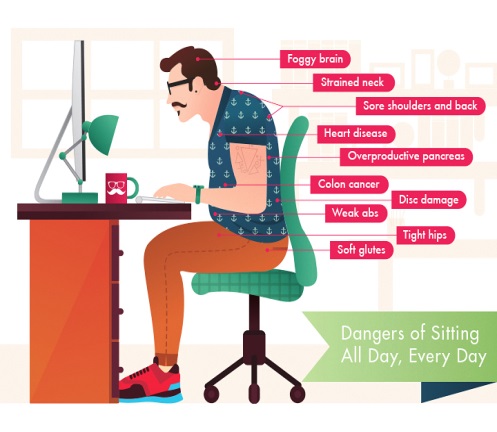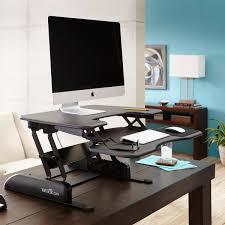In this post we stray a little from our recent interests in self sufficiency and minimizing waste to discuss a health concern we learned about that we felt important enough to share.
There is a lot of recent writing about the dangers associated with a sedentary lifestyle. Those of us who spend our day sitting at a desk or in front of a computer are told that we should exercise more. But what if the problem is not just the lack of exercise, but the actual sitting itself? It does seem somewhat intuitive that sitting down and hunching over a PC for hours during the day is not really what our bodies were meant to be doing. The convention at most office workplaces has meant that we now sit for up to 8 hours each day with few breaks, then drive home (seated) and possibly sit for more hours in the evening for relaxation. I myself have spent many hours doing so for nearly 20 years now. Thankfully I work for a company that is very aware of the ergonomic risks associated with the standard desk work setup and much effort is spent on educating people about the risks of repetitive strain injuries. This may help prevent aches and pains, but what about the more serious risks?
I came across this article and discovered it was one of many summarizing the newly identified dangers associated with sitting for extended periods.
To highlight some findings in the article:
One study compared adults who spent less than two hours a day seated (in front of the TV or other screen-based activity) with those who logged more than four hours a day of recreational screen time. Those with greater screen time (seated time) had:
- A nearly 50 percent increased risk of death from any cause
- About a 125 percent increased risk of events associated with cardiovascular disease, such as chest pain (angina) or heart attack
To me, these are shocking numbers caused by something considered so benign. The article goes on to say that these damaging effects are not counteracted by gym time or other exercise – the damage from sitting is done and remains. Some other headlines declared that sitting was “the new smoking”. I knew I had to do something about this.
Standing desks are nothing new, but in my experience they were reserved for people with significant back problems and the standing office arrangements tended to be prescribed for those issues. I was so bothered by the apparent health effects that I had to try this out. Getting a state of the art electrically adjustable standing / seating desk will cost from €1000 upwards, and so I wanted to be sure I could or would stick with this for the longer term before spending the money.
 You can see my DIY version here. I am happy to report it works very well. Those are packing Styrofoam blocks under a board that my keyboard is sitting on. The height should be such that your elbows are at approximately 90 degrees w
You can see my DIY version here. I am happy to report it works very well. Those are packing Styrofoam blocks under a board that my keyboard is sitting on. The height should be such that your elbows are at approximately 90 degrees w hen using the keyboard, and the monitor top should be at your eye level. In my case I had the luxury of being able to leave space for my laptop at a lower level as well as being able to easily switch the mouse and keyboard from the higher position to the lower position providing the easy option to sit when I wanted. This turns out to be necessary. I’m now sitting only 10-20% of the time I’m in front of the computer.
hen using the keyboard, and the monitor top should be at your eye level. In my case I had the luxury of being able to leave space for my laptop at a lower level as well as being able to easily switch the mouse and keyboard from the higher position to the lower position providing the easy option to sit when I wanted. This turns out to be necessary. I’m now sitting only 10-20% of the time I’m in front of the computer.
Standing for hours has its own risks and, depending on your physical condition, can tire you out quickly, so the best option would seem to be a mix of standing and sitting. The big advantage of standing for some of the work day is that, apart from keeping your metabolism running at a higher rate, you tend to move around a lot more on your feet, which is exactly why standing is so much better for your body.
Six months into my experiment and going strong, I have noticed:
- I work a little more efficiently as when standing I seem to be more attentive to what I’m doing and more eager to finish it.
- My posture has improved (shoulder droop is slowly reversing) – this seems to happen naturally as it’s more comfortable when standing to keep your back straight.
- I will more quickly walk away to do something I need to do as opposed to mentally deciding when seated, that you can wait until you need to get up to go do that thing. Walking up to your standing desk to engage in work, instead of flopping into a comfy chair seems to keep your brain more alert and attentive.
- I don’t get any post lunch slump anymore…you know that low energy feeling when a heavy lunch is being digested. Maybe it’s because standing and associated movements trigger metabolic processes that might otherwise stall while you are sitting and digesting your lunch
I should point out though that I did have some minor back pain during the first two weeks of doing this. It may just have been due to not adjusting my heights (keyboard, monitor) just right initially and then tweaking these over time. Or is may have been as simple as my back, curved over years by seated computing (see the image at the start of the article), was realigning and strengthening in areas it needed to use to keep me standing. Anyway, it passed, and now I have no hint of any back pain. But if you try this, be aware that you may experience this and may need to push through it, or it may be your body telling you that standing for lengths of time isn’t for you.
I do highly recommend giving this a try as I can honestly say I feel the benefits every day now, and I know it’s better for me. In a few years we may wonder at how we allowed this sedentary workplace practice to go unchecked for so long.
Also note that you can purchase cheaper standing alternatives like this one (Varidesk pro plus 30) to get you going, or as we prefer here at WeMakeDo…making your own from odds and ends is a very easy task and potentially life extending!



